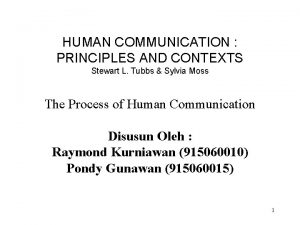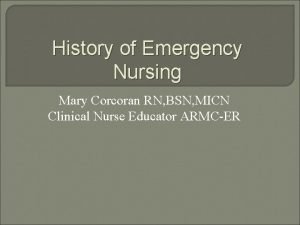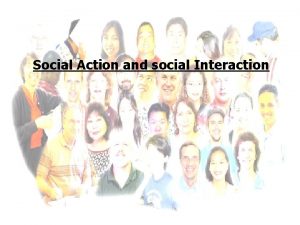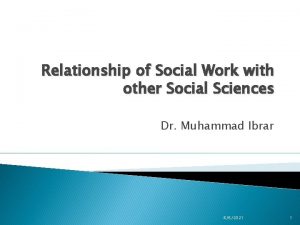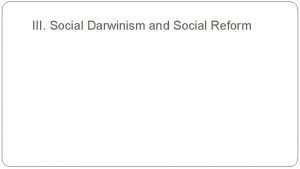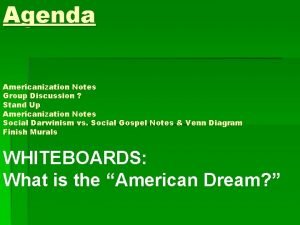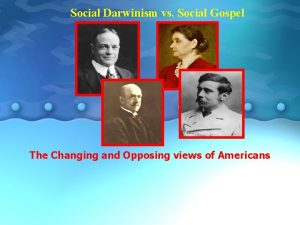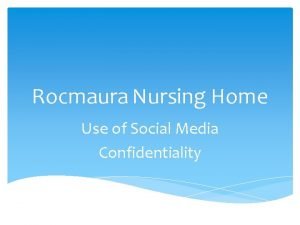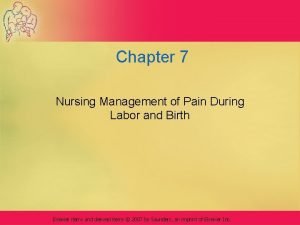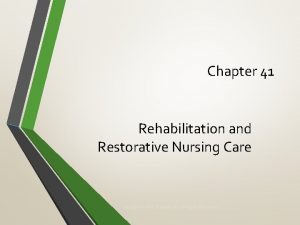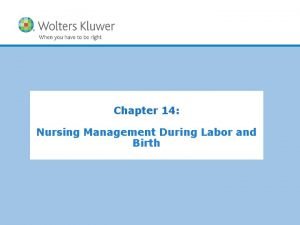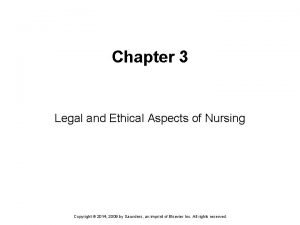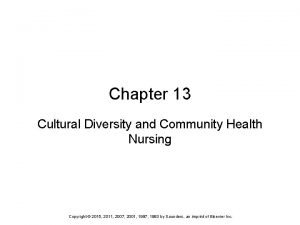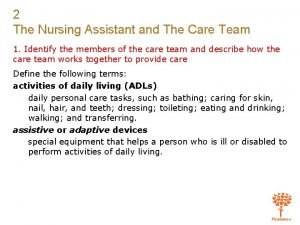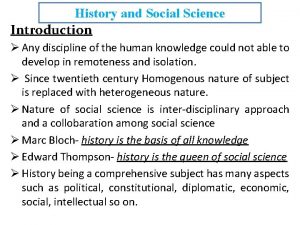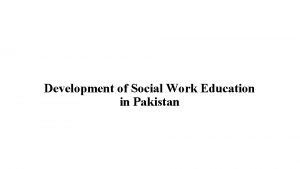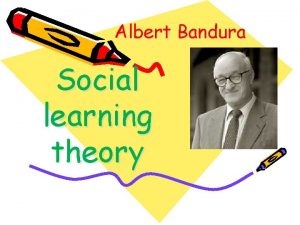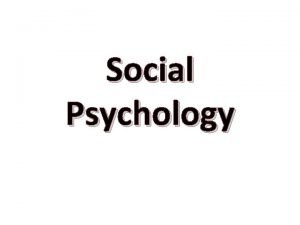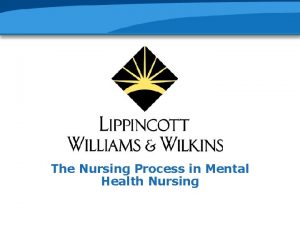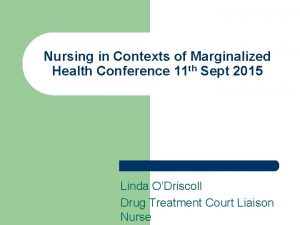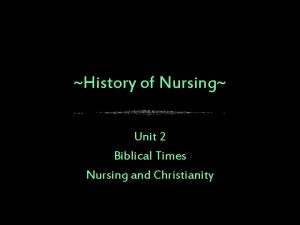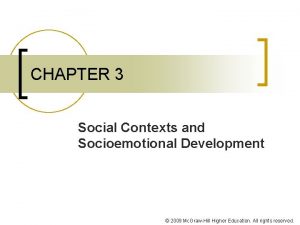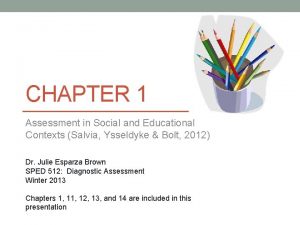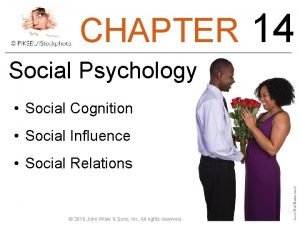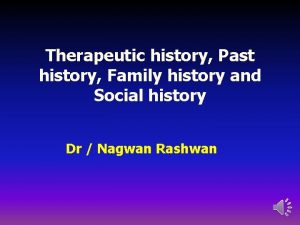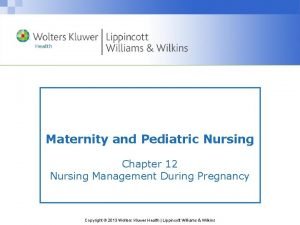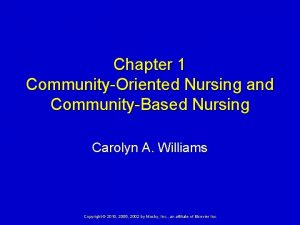Chapter 2 History and Social Contexts of Nursing














































- Slides: 46

Chapter 2 History and Social Contexts of Nursing Copyright © 2017 by Elsevier Inc. All rights reserved.

Mid-19 th Century Nursing in England Florence Nightingale and the role of women Role of women Training: Kaiserswerth, Germany and Sisters of Charity, Paris Crimean War (1854– 1956) – hospital set-up in Scutari, Turkey Data collection on morbidity and mortality helped reform the British medical system. 1859: Notes on Nursing: What it is and what it is not – a body of nursing knowledge and professional nursing 1860: Established first training school for nurses at St. Thomas’ Hospital in London Copyright © 2017 by Elsevier Inc. All rights reserved. 2

Mid-19 th Century Nursing in England Florence Nightingale and the role of women Gill and Gill (2005): “Nightingale’s influence today extends beyond her undeniable impact on the field of modern nursing to the areas of infection control, hospital epidemiology, and hospice care” (p. 1799). Copyright © 2017 by Elsevier Inc. All rights reserved. 3

Mid-19 th Century Nursing in England Mary Seacole (1805– 1881) Jamaican nurse and businesswoman. Greatest black Briton. Did not work with Nightingale during the Crimean War. She was rejected by Nightingale. Expert on cholera – managed the care of the soldiers of Crimea Was it possible that American prejudices against colour had some root here? Did these ladies shrink from accepting my aid because my blood flowed beneath a somewhat duskier skin than theirs? ” (Spartacus Educational, 2014) Copyright © 2017 by Elsevier Inc. All rights reserved. 4

1861– 1873: The American Civil War An Impetus for Training for Nursing No available professional nurses at the start of the Civil War. Catholic orders served as nurses. Call to duty: Emergence of nurses and nurse leaders Dorothea L. Dix – superintendent of women nurses by union army. Trained nurses who were employable post-war. Ø Sojourner Truth (abolitionist) and Harriet Tubman (former slave, led slaves to freedom) as nurses Ø Susie King Taylor – taught soldiers to “read and write” Ø Copyright © 2017 by Elsevier Inc. All rights reserved. 5

1861– 1873: The American Civil War An Impetus for Training for Nursing Call to duty: Emergence of nurses and nurse leaders Mary Ann (“Mother”) Bickerdyke – lay person who made cleanliness a priority (brought “order out of chaos”) Ø Clara Barton (“Angel of the Battlefield”) – set-up field hospital for the wounded and dying in Culpeper, Virginia. Founded American Red Cross Ø Copyright © 2017 by Elsevier Inc. All rights reserved. 6

1861– 1873: The American Civil War An Impetus for Training for Nursing Call to duty: Women of the South Superintendent Sallie Thompkins – “captain of Calvary” by Confederate President Jefferson Davis. Ø Phoebe Pember – matron of hospital (Chimborazo Hospital in Richmond, Virginia) Ø Civil War and Nursing It helped advance professional nursing practice. These leaders, though largely untrained, achieved dramatic improvements in care. Ø The success in the reform of military hospitals served as a model for reform of civilian hospitals nationwide. Ø Copyright © 2017 by Elsevier Inc. All rights reserved. 7

After the Civil War: Moving toward Education and Licensure under the Challenges of Segregation 1861: Sanitary Commission – relief agency to support wounded and sick soldiers Ø 1869: American Medical Association meeting. Chair – Samuel Gross Ø Lobby for creation of nursing schools (Donahue, 1996) Recommend training schools for nurses in large hospitals Inadequate conditions in many hospitals sparked the need for social reform. Copyright © 2017 by Elsevier Inc. All rights reserved. 8

First Training Schools for Nurses and Feminizing of Nursing 1873 – Nightingale school-modeled training schools in America Ø Ø Ø Bellevue Training School for Nurses in New York City Connecticut Training School for Nurses in New Haven Boston Training School for Nurses at Massachusetts General Hospital in Boston Linda Richards – first trained nurse in the US Victorian belief – feminine qualities in a nurse + men prevented from entering the profession 1900 – nursing schools provided steady, subservient, female, student nurse, hospital workforce Copyright © 2017 by Elsevier Inc. All rights reserved. 9

First Training Schools for Nurses and Feminizing of Nursing Segregation in Nursing Ø Ø Ø New England Hospital for Women and Children, Boston – admitted one African-American and Jewish student who met qualifications 1886 – Atlanta Baptist Female Seminary (later: Spelman College) in Atlanta, GA. 2 -year-long diploma program. • Closed: 1928. Graduated 117 nurses. 1886 – School for Male Nurses, NY Training School 1888 – Mills College of Nursing at Bellevue Hospital 1898 – Alexian Brothers Hospital, Chicago 1928 – Alexian Brothers Hospital, St. Louis Copyright © 2017 by Elsevier Inc. All rights reserved. 10

Professionalization through Organization 1893: Chicago World’s Fair – meeting of the minds Ø Isabel Hampton Robb – protested the lack of uniformity across nursing schools (inadequate curriculum development and nursing education) • 1896: Founded Nurses’ Associated Alumnae of the United States and Canada 1911: It became American Nurses Association Copyright © 2017 by Elsevier Inc. All rights reserved. 11

Professionalization through Organization 1893: Chicago World’s Fair – meeting of the minds Ø National League for Nursing, the American Society of Superintendents of Training Schools for Nurses – was formed to address issues in nursing education • 1912: National League of Nursing Education (NLNE) • 1952: National League for Nursing (NLN). Copyright © 2017 by Elsevier Inc. All rights reserved. 12

Professionalization through Organization 1899: International Council of Nurses (ICN) Dedicated to uniting nursing organizations of all nations Ø 1901: First meeting: World Exposition, Buffalo, NY Ø Segregation among organizations ANA excluded minority nurses until 1916. Ø 1908: National Association of Colored Graduate Nurses (NACGN) in New York • Objectives: Achieve higher professional standards, breakdown Ø discriminatory practices faced by African Americans in schools of nursing and nursing organizations, and develop leadership among African American nurses • They had met their objectives. It disbanded in 1951. Copyright © 2017 by Elsevier Inc. All rights reserved. 13

Nursing’s Focus on Social Justice: The Henry Street Settlement Early in 20 th Century Influx of immigrants and factory work in northeastern US Ø Infections and overcrowding in inner city tenements Ø 1893: Establishment of Henry Street Settlement • Lillian Wald and Lavinia Dock • They sought finances and formalized public health. • They treated minor illnesses, prevented disease transmission, Ø and provided health education. Ø Margaret Sanger and Lower East Side (Kennedy, 1970) • Immigrant women • Safe contraception and family planning Copyright © 2017 by Elsevier Inc. All rights reserved. 14

A Common Cause, but Still Segregated Tuberculosis and African Americans Racial barriers and cultural resistance to seeking medical care Ø Charity Organization Society: President Edward T. Devine • Provide a Black district nurse to work with African Americans • Jessie Sleet Scales and “A Successful Experiment” Ø With Elizabeth Tyler – established Stillman House (a branch of Henry Street Settlement) They focused on disease prevention and management of illness. The Stillman House signifies activism, expansion, and growth. Copyright © 2017 by Elsevier Inc. All rights reserved. 15

Spanish-American War Creates the Need for Nurses 1898: US Congress declared war on Spain. Anita M. Mc. Gee MD – head of Hospital Corps Ø Recruitment of graduate nurses Typhoid epidemic created a greater need for nurses Namahyoke Curtis – contract nurse, first trained African American Development of Army Nurse Corps (1901) and Navy Nurse Corps (1908) Copyright © 2017 by Elsevier Inc. All rights reserved. 16

Professionalization and Standardization of Nursing through Licensure Early 20 th century – early efforts at licensure ICN resolution: Each country and state to provide for licensure of the nurses 1903: Permissive licensure laws: Nurses did not have to be registered to practice but could not use the title of registered nurse (RN) unless registered. Ø 1923: All states required permissive licensure Ø 1947: New York fully mandated licensure Ø 1950: NLN and first nationwide State Board Test Pool Examination Ø Copyright © 2017 by Elsevier Inc. All rights reserved. 17

1917– 1930: The Challenges of the Flu Epidemic, World War I, and the Early Depression Era 1917: US entered World War I and influenza pandemic Mary Adelaide Nutting and National Committee on Nursing Charged with adequate supply of nurses Ø Army School of Nursing with Annie Goodrich as dean Ø Vassar Training Camp for Nurses Ø Red Cross nursing – widespread public education in home care and hygiene 1920: Congress passed a bill that provided nurses with military rank. Copyright © 2017 by Elsevier Inc. All rights reserved. 18

1917– 1930: The Challenges of the Flu Epidemic, World War I, and the Early Depression Era 1923: Goldmark Report – study of nursing education Advocated for establishment of schools of nursing associated with colleges and universities Ø Encouraged establishment of rural programs of midwifery Ø 1925: Mary Breckinridge and Frontier Nursing Service Implication: Through this rural midwifery service, Breckinridge demonstrated that nurses could play a significant role in providing primary rural health care. Copyright © 2017 by Elsevier Inc. All rights reserved. 19

1931– 1945: Challenges of the Great Depression and World War II The Great Depression: Many families could no longer afford private duty nurses, forcing many nurses into unemployment. 1933: President Franklin D. Roosevelt and Civil Works Administration Social Security Act of 1935 enhanced the practice of public health nursing. Ø Purpose: Strengthen public health services and provide medical care for children with disability and blind persons. Copyright © 2017 by Elsevier Inc. All rights reserved. 20

World War II: Challenges and Opportunities for Nursing The need for more nurses Congress enacted substantial support for nursing education Military and collegiate programs of nursing formed the Cadet Nurse Corps. Ø Schooling in exchange for commitment to serve (Robinson and Perry, 2001) Ø 1943– 1948: 124, 000 nurses volunteered, graduated, and certified for military services in the Army and Navy Nurse Corps Ø Copyright © 2017 by Elsevier Inc. All rights reserved. 21

1945– 1960: The Rise of Hospitals— Bureaucracy, Science, and Shortages 1946: Hill-Burton Act Growth of new facilities and increased need for nurses Ø Collective bargaining Ø Team nursing and associate degree in nursing Ø 1947: Military nurses were awarded full commissioned officer status in both Army and Navy Nurse Corps. End of segregation Ø Julie O. Flikke – first nurse to be promoted to the rank of colonel in US Army Ø 1954: Men allowed in military nursing corps Copyright © 2017 by Elsevier Inc. All rights reserved. 22

1961– 1982: The Great Society, Vietnam, and the Change in Women’s Role 1960: Era of specialty care and clinical specialization 1965: Social Security Act amended Medicare and Medicaid Ø Reliance on Medicare an Medicaid reimbursements Ø Hospital as preferred care (and work) setting Ø Vietnam War Mobile hospitals and nurses Ø Beyond the roles and responsibilities Ø PTSD among nurses and soldiers Ø Copyright © 2017 by Elsevier Inc. All rights reserved. 23

1983– 2000: Challenges for Nursing— HIV/AIDS and Life Support Technologies Early 1980 s: HIV Universal precautions Ø Changes in equipment – needles, IV catheters, gloves Ø 1980 – 1990 s: Medical Technology and life support Karen Ann Quinlan Ø Nancy Cruzan Ø Copyright © 2017 by Elsevier Inc. All rights reserved. 24

2001– 2015: The Post– 9/11 Era, Natural Disasters, and Health Care Reform 2001: World Trade Center – Disaster management with focus on saving as many lives 2005: Hurricane Katrina – Provision of care under horrendous conditions 2006: ANA statement of nursing actions in “unfamiliar and unusual conditions” 2010: Affordable Care Act and incremental implementation Information and medical technologies Copyright © 2017 by Elsevier Inc. All rights reserved. 25

Social Context of Nursing: Gender Mid-1800 s: Women’s social roles Ø Stereotype: Women were intellectually inferior to men, and hence women were not called on to make decisions or think for themselves. 11, 12, and 13 th century: men as nurses under military and religious orders Ø Stereotype: Men supply strength or control of patients when needed (psychiatric nursing). Copyright © 2017 by Elsevier Inc. All rights reserved. 26

Social Context of Nursing: Gender Men are likely to be younger, employed full-time in nursing, have non-nursing education, and nursing is a second career. Reasons why men become nurses: Desire to help people 2. Nursing is a growth profession with career paths 3. Desire for a stable career 1. 1974: American Assembly for Men in Nursing (AAMN) Copyright © 2017 by Elsevier Inc. All rights reserved. 27

Social Context of Nursing: Gender 1960 s: Profound effect on women Ø Nursing promises economic and job security. Ø Women explore career opportunities beyond stereotypes and tradition. Nursing’s appeal is strong to individuals who want to make a difference in the lives of others. Women’s movement benefitted nursing. Exposed economic inequities Ø Education in colleges and universities and lessons of power and change Ø Copyright © 2017 by Elsevier Inc. All rights reserved. 28

Social Context: Image of Nursing Media depiction of nurses Nursing caps and other forms of identification First names versus last names. Gordon (2005), in an informal survey of approximately 30 lay people, found that the respondents did not think it would be odd for nurses to refer to themselves more formally. Nurse Ratched in “One Flew Over the Cuckoo’s Nest” 2014 Gallup: Nurses were rated the highest among a number of professions and occupations on honesty and ethics. Copyright © 2017 by Elsevier Inc. All rights reserved. 29

Woodhull Study on Nursing and the Media Sponsor: Sigma Theta Tau International (STTI) Comprehensive study of nursing in print media Sep 1997 “Nurses and the nursing profession are essentially invisible to the media and, consequently, to the American public” Copyright © 2017 by Elsevier Inc. All rights reserved. 30

Johnson & Johnson Campaign 2002: Campaign for Nursing’s Future – “to enhance the image of nursing profession, recruit new nurses and educators, and to retain nurses currently in the system” (Donelan, Buerhaus, Ulrich, et al. , 2005). Includes initiatives in print media, television advertising, student scholarships, fundraising, and research. This landmark effort provides a stimulus to the nursing profession to partner with other entities to continue the quest for an accurate image of professional nursing, thereby addressing the nursing shortage. Copyright © 2017 by Elsevier Inc. All rights reserved. 31

Truth about Nursing The Truth about Nursing is a nonprofit organization with the mission to “increase public understanding of the central, front-line role nurses play in modern health care” (Truth about Nursing, 2015). Nursing can take responsibility for its public image. Nurses can become sensitive to portrayals of nurses and nursing in the media. Then, take action… Copyright © 2017 by Elsevier Inc. All rights reserved. 32

National Population Trends: Aging of America People are living longer. The number of elderly people is increasing as the number of adults in early midlife is decreasing. Ø Profound effect on health care system and nursing profession Current nursing strategies: Care of elderly in nursing programs Ø Gerontology courses Ø Gerontological clinical nurse specialists and NPs Ø Copyright © 2017 by Elsevier Inc. All rights reserved. 33

National Population Trends: Diversity Africans and deep distrust of health care system US Public Health Service Syphilis Study at Tuskegee Ø African Americans and Hispanics differed from Whites in that they expected discrimination in the health care system; in particular, African Americans expected to be experimented on, which fostered distrust (Jacobs, et al. , 2011). Ø Copyright © 2017 by Elsevier Inc. All rights reserved. 34

National Population Trends: Diversity First decade of the 21 st century: Significant immigration of Latinos from Mexico and other Central and South American countries Different values, health beliefs, and practices and find assimilation into the dominant culture is difficult They are increasingly appreciated for the uniqueness and flavor they bring to life in the United States. Many prefer to preserve their own cultural heritage rather than becoming “Americanized. ” Copyright © 2017 by Elsevier Inc. All rights reserved. 35

National Population Trends: Diversity Concepts of race depends on “self-identification by respondents; that is, the individual’s perception of his/her racial identity” (U. S. Bureau of the Census, 2002, p. 5). Information on race and ethnicity is critical in policy decision making. Particularly important to health care is the ability to assess health disparities and environmental risk (CDC, 2013). Copyright © 2017 by Elsevier Inc. All rights reserved. 36

Social Context: Diversity in the Profession Nurses need to be educated to be aware and respectful of culture differences. Cultural competence, cultural sensitivity, and cultural humility Copyright © 2017 by Elsevier Inc. All rights reserved. 37

Social Context: Technological Developments Genetics, genomics, and epigenetics Human Genome Project Funded by National Institutes of Health Ø Mapped out 20, 000 to 25, 000 genes on the human genome Ø Significant effect on understanding health and illness Ø Copyright © 2017 by Elsevier Inc. All rights reserved. 38

Social Context: Technological Developments Pharmacogenetics – mechanism of action can be determined by genetic structures Biomedical technology – complex machines or implantable devices Nurses assume responsibility. Ø Do not forget: There is a “human in there” under all lines and monitors. Ø Copyright © 2017 by Elsevier Inc. All rights reserved. 39

Social Context: Technological Developments IT – Information Technology – computer-based applications used to communicate, store, manage, retrieve, and process information Meaningful use Ø Centers for Medicare and Medicaid Services Ø Paperless Ø Access and confidentiality Ø Knowledge technology Telehealth Intentional caring and technology Copyright © 2017 by Elsevier Inc. All rights reserved. 40

Social Context: Nursing Shortage Causes of nursing shortage Internal causes Ø External causes Ø Shortage of nursing faculty Doctoral-prepared and masters prepared are more than 50 years of age Ø Nurses with advanced degreed are hired in more lucrative private sector Ø Not enough doctoral- or master’s prepared nurses are produced to meet demands for education Ø Copyright © 2017 by Elsevier Inc. All rights reserved. 41

Social Context: Nursing Shortage Causes of nursing shortage Internal causes Ø External causes Ø Shortage of nursing faculty Doctoral-prepared and masters prepared are more than 50 years of age Ø Nurses with advanced degreed are hired in more lucrative private sector Ø Not enough doctoral- or master’s prepared nurses are produced to meet demands for education Ø Copyright © 2017 by Elsevier Inc. All rights reserved. 42

Social Context: Nursing Shortage Two Solutions for Shortage of RNs Increase supply of nurses • Import from English speaking countries • Travel nursing Ø Create less trained workers to supplement nursing workforce • Shorter training and education Ø Contributing factors to nursing shortage: aging nurses and population Copyright © 2017 by Elsevier Inc. All rights reserved. 43

Initiatives to Provide Stable Workforce of Registered Nurses Dramatic swings in supply and demand for nurses Harm the profession Ø Jeopardize care Ø Cost Ø Four Major Initiatives American Recovery and Reinvestment Act of 2009 Ø Robert Wood Foundation Ø Johnson & Johnson’s Campaign for Nursing’s Future Ø ANCC Magnet Recognition Program Ø Copyright © 2017 by Elsevier Inc. All rights reserved. 44

What is a correct statement regarding Florence Nightingale’s contribution to professional nursing? 1. She advocated for nursing licensure. 2. She encouraged gender equality in nursing practice. 3. She established training schools for nurses. 4. She promoted inclusion of colored nurses. Copyright © 2017 by Elsevier Inc. All rights reserved. 45

What are internal causes of nursing shortages? 1. 2. 3. 4. Aging of the population Greater patient acuity Multiple options for women Salary issues Copyright © 2017 by Elsevier Inc. All rights reserved. 46
 What sociological perspective stresses that age
What sociological perspective stresses that age Shape matching and object recognition using shape contexts
Shape matching and object recognition using shape contexts Model komunikasi tubbs
Model komunikasi tubbs Shape matching and object recognition using shape contexts
Shape matching and object recognition using shape contexts Professional context examples
Professional context examples Writing in academic contexts
Writing in academic contexts Teachers in crisis contexts
Teachers in crisis contexts An srs document normally contains
An srs document normally contains Global context
Global context Intercultural communication in contexts
Intercultural communication in contexts Social thinking social influence social relations
Social thinking social influence social relations Social thinking social influence social relations
Social thinking social influence social relations Functional nursing model
Functional nursing model Social darwinism vs social gospel answer key
Social darwinism vs social gospel answer key Nursing care plan for obsessive compulsive disorder
Nursing care plan for obsessive compulsive disorder Nursing diagnosis of cataract
Nursing diagnosis of cataract Psychiatric nursing process
Psychiatric nursing process Nursing process in psychiatric nursing
Nursing process in psychiatric nursing History of nursing in sudan
History of nursing in sudan Patient cc
Patient cc History of west african college of nursing
History of west african college of nursing Father of psychiatric nursing in india
Father of psychiatric nursing in india History of emergency nursing
History of emergency nursing History also history physical
History also history physical Social action vs social interaction
Social action vs social interaction Relationship of social work with other social sciences
Relationship of social work with other social sciences Social thinking and social influence in psychology
Social thinking and social influence in psychology What was reform darwinism
What was reform darwinism Social darwinism and social gospel venn diagram
Social darwinism and social gospel venn diagram Define social darwinism and social gospel.
Define social darwinism and social gospel. Global agenda for social work and social development
Global agenda for social work and social development Social bonds theory
Social bonds theory Social thinking and social influence
Social thinking and social influence Rocmaura nursing home
Rocmaura nursing home Chapter 7 nursing management of pain during labor and birth
Chapter 7 nursing management of pain during labor and birth Chapter 41 rehabilitation and restorative nursing care
Chapter 41 rehabilitation and restorative nursing care Chapter 14 nursing management during labor and birth
Chapter 14 nursing management during labor and birth Chapter 3 legal and ethical issues
Chapter 3 legal and ethical issues Chapter 13 cultural diversity and community health nursing
Chapter 13 cultural diversity and community health nursing Chapter 2 the nursing assistant and the care team
Chapter 2 the nursing assistant and the care team Chapter 2 the nursing assistant and the care team
Chapter 2 the nursing assistant and the care team Introduction to the discipline of history
Introduction to the discipline of history Social work history in pakistan
Social work history in pakistan Social learning theory history
Social learning theory history Aristotle university of thessaloniki psychology
Aristotle university of thessaloniki psychology Chapter 1 history and trends of health care
Chapter 1 history and trends of health care Chapter 5 policing history and structure
Chapter 5 policing history and structure


